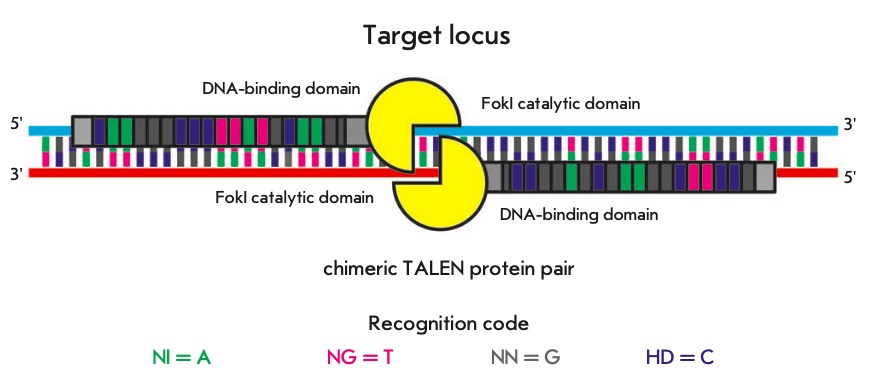Transcription Activator-Like Effector Nuclease
Recently, transcription activator-like effector (TALE) nucleases (TALENs) have emerged as a revolutionary gene editing tool in various organisms and cell types. TALEN technology leverages artificial restriction enzymes generated by fusing a TAL effector DNA-binding domain to a DNA cleavage domain. That means that TALENs are fusion proteins of a bacterial TALE protein and FokI endonuclease.
The site-specific chromosomal double-strand breaks introduced via TALENs significantly increase the efficiency of genomic modification. The modular nature of the TALE central repeat domains enables scientists to tailor DNA recognition specificity with ease and target essentially any desired DNA sequence.
Introduction
TALENs have generated much interest and excitement because they can be very easily and rapidly designed by researchers using a simple 'protein-DNA code' that relates modular DNA-binding TALE repeat domains to individual bases in a target-binding site.
Restriction enzymes are a type of enzymes that cut DNA strands at a specific sequence. TALEs are able to be quickly engineered to bind practically any desired DNA sequence. By combining such an engineered TALE with a DNA cleavage domain (which cuts DNA strands), one can engineer restriction enzymes that will specifically cut any desired DNA sequence. When these restriction enzymes are introduced into cells, they can be used for gene editing or genome editing in situ, a technique known as genome editing with engineered nucleases.
How Transcription Activator-Like Effector Nuclease Works?
TALENs use the non-specific FokI domain as the DNA cleavage module and function as dimers. TALENs work as pairs and their bindings sites are chosen so that they are located on opposite DNA strands and are separated by a small fragment (12-25 bp), a spacer sequence. Once in the nucleus, artificial nucleases bind to target sites: the FokI domains located at the C-termini of a chimeric protein dimerize to cause a double-strand break in a spacer sequence.
For introducing a double-strand break using chimeric TALEN proteins, the process is shown below Fig.1. One monomer of the DNA-binding protein domain recognizes one nucleotide of a target DNA sequence. Two amino acid residues in the monomer are responsible for binding. The recognition code (single-letter notation is used to designate amino acid residues) is provided. Recognition sites are located on the opposite DNA strands at a distance sufficient for the dimerization of the FokI catalytic domains. Dimerized FokI introduces a double-strand break into DNA.
 Figure 1. Introducing a double-strand break using chimeric TALEN proteins. (Nemudryi, 2014)
Figure 1. Introducing a double-strand break using chimeric TALEN proteins. (Nemudryi, 2014)
Structure
A TALEN is composed of an N-terminal segment (NTS, pink box), a central repeat domain, a C-terminal segment (CTS, cyan box), and a FokIcatalytic domain (orange oval). The central repeat domain comprises a series of repeat units that are responsible for specific recognition of thymine (red boxes), adenine (green boxes), cytosine (blue boxes), and guanine (yellow boxes). The formation of a heterodimer by two TALENs in a tail-to-tail orientation at the target site executes a site-specific DNA double-strand break. The TALE binding sites on the target DNA are shown in black and the spacer is shown in gray.
Applications
TALEN is extensively used for various genome manipulations, allowing one to solve complex problems, including the mutant and transgenic plants and animals' generation, development and investigation of disease models based on cultured human pluripotent cells. Furthermore, chimeric proteins based on the TALE DNA-binding domains were used in experiments on the regulation of gene transcription and for studying the epigenomes and behavior of chromosomal loci in the cell cycle. Some groups have used TALENs to modify endogenous genes in yeast, fruit fly, roundworm, crickets, zebrafish, frog, rat, pig, cow, thale cress, rice, silkworm, and human somatic and pluripotent stem cells.
In a word, TALEN comprises a non-specific FokI nuclease domain fused to a customizable DNA-binding domain. TALEN is one of the gene editing tools and characterized by a relative construction simplicity and a high functional efficiency in human, animal, and plant cells.
Reference
- Nemudryi, A. A.; et al. (2014). TALEN and CRISPR/Cas genome editing systems: tools of discovery. Acta Naturae. 6(3): 19-40. Distributed under Open Access license CC BY 4.0, without modification.
